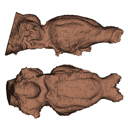3D models of early strepsirrhine primate teeth from North Africa
3D models of Miocene vertebrates from Tavers
3D models of Protosilvestria sculpta and Coloboderes roqueprunetherion
3D GM dataset of bird skeletal variation
Skeletal embryonic development in the catshark
Bony connexions of the petrosal bone of extant hippos
bony labyrinth (11) , inner ear (10) , Eocene (8) , South America (8) , Paleobiogeography (7) , skull (7) , phylogeny (6)
Lionel Hautier (22) , Maëva Judith Orliac (21) , Laurent Marivaux (16) , Rodolphe Tabuce (14) , Bastien Mennecart (13) , Pierre-Olivier Antoine (12) , Renaud Lebrun (11)
MorphoMuseuM Volume 07, issue 04
<< prev. article next article >>

|
Original article : anatomy atlasBrain damage: the endocranial cast of Mixtotherium cuspidatum (Mammalia, Artiodactyla) from the Victor Brun Museum (Montauban, France)Maëva J. Orliac
Published online: 25/11/2021 |

|
M3#857endocast of the brain cavity Type: "3D_surfaces"doi: 10.18563/m3.sf.857 state:published |
Download 3D surface file |
Anthony R., Grzybowski J. 1930. Le Neopallium des Équidés: Étude du Développement de ses Plissements. Journal of Anatomy 64(2), 147-169.
Blondel C. 2001. The Eocene–Oligocene ungulates from Western Europe and their environment. Palaeogeography, Palaeoclimatology, Palaeoecology 168(12), 125-139. https://doi.org/10.1016/S0031-0182(00)00252-2
Dechaseaux C. 1969. Moulages endocrâniens d'artiodactyles primitifs. Essai sur l'histoire du néopallium. Annales de Paléontologie 60, 195-248.
Dechaseaux C. 1973. Essais de paléoneurologie. Annales de Paléontologie 59(1), 115-132.
Erfurt J., Métais G. 2007. Endemic European Paleogene artiodactyls: Cebochoeridae, Choeropotamidae, Mixtotheriidae, Cainotheriidae, Anoplotheriidae, Xiphodontidae, and Amphimerycidae. In: Prothero D. R., Foss S.E. (Eds.), The Evolution of Artiodactyls. Johns Hopkins University Press, Baltimore, pp. 59-84.
Filhol H. 1880. Sur la découverte de mammifères nouveaux dans les dépôts de phosphate de chaux du Quercy. Comptes rendus de l’Académie des Sciences, Paris 90, 1579-1580. https://doi.org/10.5962/bhl.part.14445
Gentry A. W., Hooker J. J. 1988. The phylogeny of the Artiodactyla. In: Benton M. J. (Ed.) The phylogeny and classification of the tetrapods: Volume 2, mammals. Clarendon Press, Oxford, pp. 235–272.
Godinot,M., Couette S. 2008. Morphological diversity in the skulls of large adapines (Primates, Adapiformes) and its systematic implications. In: Sargis E. J., Dagosto M. (Eds.), Mammalian Evolutionary Morphology. Springer, Dordrecht, pp. 285-313. https://doi.org/10.1007/978-1-4020-6997-0_12
Hooker J. J. 1986. Mammals from the Bartonian (middle/late Eocene) of the Hampshire Basin, southern England. Bulletin of the British Museum of natural History (Geol.) 39(4), 191-478.
Hooker J. J., Weidmann M. 2000. The Eocene mammal faunas of Mormont, Switzerland: systematic revision and resolutions of dating problems. Schweizerische Paläontologische Abhandlungen 120, 1-143.
Janis C. 1990. Correlation of cranial and dental variables with body size in ungulates and macropodoids. In: Damuth J., MacFadden B. J. (Eds.), Body size in mammalian paleobiology: estimation and biological implications. Cambridge, UK: Cambridge University Press, pp. 255–300. https://doi.org/10.1046/j.1420-9101.1992.5030530.x
Lebrun R. 20018. MorphoDig, an open-source 3D freeware dedicated to biology. IPC5, Paris, France - 07/2018.
Luccisano V., Sudre J., Lihoreau F. 2020. Revision of the Eocene artiodactyls (Mammalia, Placentalia) from Aumelas and Saint-Martin-de-Londres (Montpellier limestones, Hérault, France) questions the early European artiodactyl radiation. Journal of Systematic Palaeontology 18(19), 1631-1656. https://doi.org/10.1080/14772019.2020.1799253
Orliac M. J., Gilissen E. 2012. Virtual endocranial cast of earliest Eocene Diacodexis (Artiodactyla, Mammalia) and morphological diversity of early artiodactyl brains. Proceeding of the Royal Society B 279(1743), 3670-3677. https://doi.org/10.1098/rspb.2012.1156
Orliac M. J., Thewissen J. G. M. 2021. The endocranial cast of Indohyus (Artiodactyla, Raoellidae): the origin of the cetacean brain. Journal of Mammalian Evolution pp 1-13. https://doi.org/10.1007/s10914-021-09552-x
Remy J. A, Crochet J. Y., Sigé B., Sudre J., De Bonis L., Vianey-Liaud M., Godinot M., Hartenberger J. L., Lange-Badré B., Comte B. 1987. Biochronologie des phosphorites du Quercy: mise à jour des listes fauniques et nouveaux gisements de mammifères fossiles. Münchner Geowissenschaftliche Abhandlungen 10(A), 169-188.
Repérant J. 1971. Morphologie comparée de l'encéphale et du moulage endocrânien chez les Tylopodes actuels (Mammifères, Artiodactyles). Bulletin du Muséum National d’Histoire Naturelle 4(4), 185-321.
Simpson G. G. 1945. The principles of classification and a classification of mammals. Bulletin of the American Museum of natural History 85, 1-350.
Smith G. E. 1902. On the homologies of the cerebral sulci. Journal of Anatomy and Physiology 36, 309-319.
Stehlin H.G. 1908. Die Säugetiere des Schweizerischen Eocaens, Cristischer Catalog der Materialen, Tome 5. Abhandlungen der schweizerischen paläontologischen Gesellschaft 34, 691-837.
Sudre J., Sigé B., Remy J.-A., Marandat B., Hartenberger J.-L., Godinot M., Crochet J.-Y., 1990. Une faune du niveau d'Egerkinger (MP 14; Bartonien inférieur) dans les phosphorites du Quercy (Sud de la France). Palaeovertebrata 20(1), 1-32.
Weppe R., Blondel C., Vianey-Liaud M., Escarguel G., Pélissié T., Antoine P.O., Orliac M. J. 2020. Cainotheriidae (Mammalia, Artiodactyla) from Dams (Quercy, SW France): phylogenetic relationships and evolution around the Eocene–Oligocene transition (MP19– MP21). Journal of Systematic Palaeontology 18(7), 541-572. https://doi.org/10.1080/14772019.2019.1645754